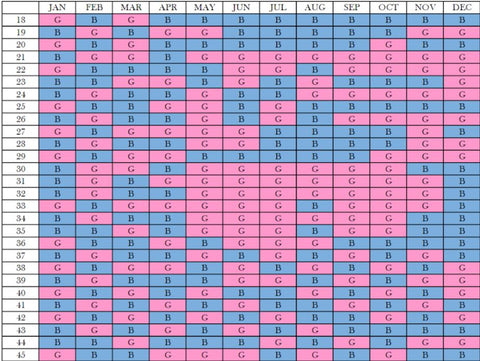Welcome to our comprehensive guide on the Chinese Gender Predictor Chart. At 4aKid, we aim to provide you with accurate and reliable information to assist you in preparing for the arrival of your little bundle of joy. In this article, we will delve into the fascinating world of the Chinese Gender Predictor Chart, its origins, how it works, and whether it can accurately predict the gender of your baby. Let's dive in!
Unraveling the Origins
The Chinese Gender Predictor Chart, also known as the Chinese Gender Calendar or Chinese Birth Chart, has a long and intriguing history. Legend has it that this ancient method of gender prediction originated in China over 700 years ago during the Ming Dynasty. It is believed to have been based on the principles of Yin and Yang, as well as the Chinese Lunar Calendar.
Understanding the Methodology
The Chinese Gender Predictor Chart follows a simple methodology. By taking into account the mother's age at conception and the month of conception, the chart claims to predict the baby's gender with remarkable accuracy. The chart consists of a grid that cross-references the mother's age with the month of conception to determine the predicted gender of the baby.
Analyzing the Chart
To help you better understand the Chinese Gender Predictor Chart, let's analyze its structure and how it works. Below is a diagram illustrating the basic layout of the chart:

The vertical axis of the chart represents the months of conception, while the horizontal axis represents the mother's age at conception. The intersection of these two factors on the chart reveals the predicted gender of the baby.
Can the Chart Accurately Predict Gender?
Now, let's address the burning question on everyone's mind - can the Chinese Gender Predictor Chart accurately predict the gender of your baby? While many swear by its accuracy, it's important to note that this chart is based on folk traditions and lacks scientific evidence to support its claims.
The accuracy rate of the Chinese Gender Predictor Chart is around 50%, which is no better than a random guess. It's crucial to remember that the gender of a baby is determined by biological factors and is not influenced by calendars or charts.
Factors Affecting Accuracy
Several factors can contribute to the discrepancy between the predicted gender and the actual gender of the baby. These factors include human error during chart interpretation, variations in lunar calendar systems, and the inherent limitations of using age and conception month as the sole determining factors.
Seeking Scientific Validation
Given the lack of scientific validation, it's essential to approach the Chinese Gender Predictor Chart with caution. If you're looking for a more accurate method of determining your baby's gender, medical technologies such as ultrasound and amniocentesis are widely considered as reliable options.
Embracing the Surprise
Ultimately, the gender of your baby is a precious surprise that will unfold in due time. While it can be exciting to explore traditional gender prediction methods, it's important to remember that they are simply for entertainment purposes. Embrace the joy and anticipation of waiting to discover your baby's gender through medically proven methods.
Conclusion
The Chinese Gender Predictor Chart is an intriguing aspect of cultural folklore. While it may spark curiosity and excitement, it's crucial to approach it with realistic expectations. Understanding its origins, methodology, and limitations empowers you to make informed decisions regarding gender prediction.
At 4aKid, we encourage you to enjoy the journey of pregnancy, embracing the surprises it brings. Remember, the true magic lies in the anticipation and love you have for your little one, regardless of their gender.
We hope this article has shed light on the Chinese Gender Predictor Chart, and we wish you a joyful and fulfilling pregnancy journey!
NEXT READ: BabyYumYum’s Chinese Gender Calculator










